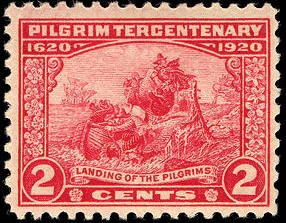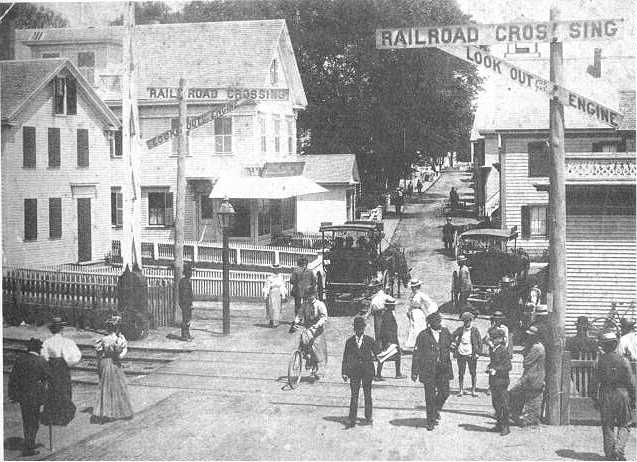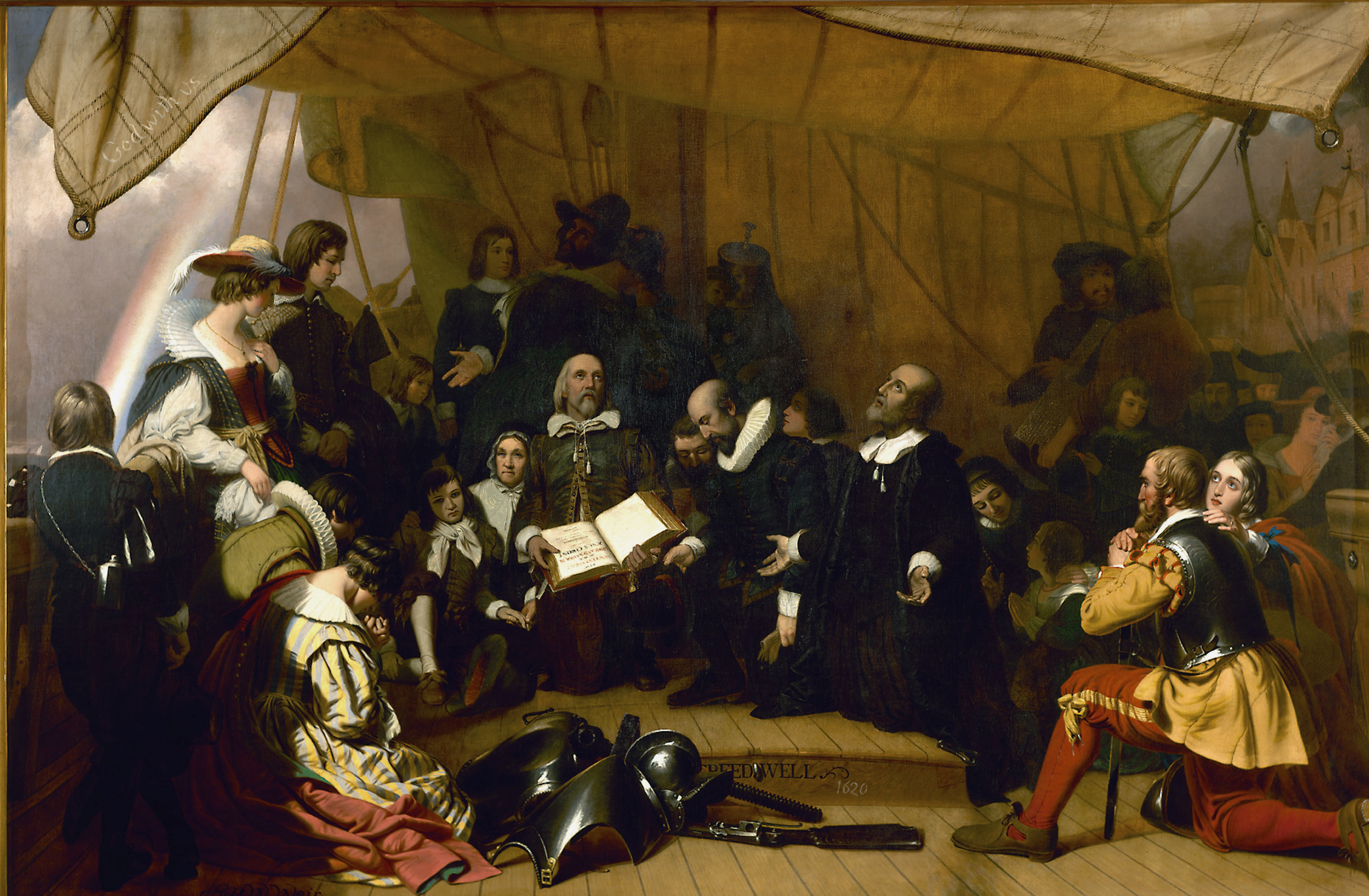|
Pilgrim Tercentenary Half Dollar
The Pilgrim Tercentenary half dollar or Pilgrim half dollar was a commemorative fifty-cent coin struck by the United States Bureau of the Mint in 1920 and 1921 to mark the 300th anniversary (tercentenary) of the arrival of the Pilgrims in North America. It was designed by Cyrus E. Dallin. Massachusetts Congressman Joseph Walsh was involved in joint federal and state efforts to mark the anniversary. He saw a reference to a proposed Maine Centennial half dollar and realized that a coin could be issued for the Pilgrim anniversary in support of the observances at Plymouth, Massachusetts. The bill moved quickly through the legislative process and became the Act of May 12, 1920. Sculptor James Earle Fraser criticized some aspects of the design, but the Treasury approved it anyway. After a promising start, sales tailed off, and tens of thousands of coins from each year were returned to the Philadelphia Mint for melting. Numismatist Q. David Bowers has cited the fact that the ... [...More Info...] [...Related Items...] OR: [Wikipedia] [Google] [Baidu] |
United States Dollar
The United States dollar ( symbol: $; code: USD; also abbreviated US$ or U.S. Dollar, to distinguish it from other dollar-denominated currencies; referred to as the dollar, U.S. dollar, American dollar, or colloquially buck) is the official currency of the United States and several other countries. The Coinage Act of 1792 introduced the U.S. dollar at par with the Spanish silver dollar, divided it into 100 cents, and authorized the minting of coins denominated in dollars and cents. U.S. banknotes are issued in the form of Federal Reserve Notes, popularly called greenbacks due to their predominantly green color. The monetary policy of the United States is conducted by the Federal Reserve System, which acts as the nation's central bank. The U.S. dollar was originally defined under a bimetallic standard of (0.7735 troy ounces) fine silver or, from 1837, fine gold, or $20.67 per troy ounce. The Gold Standard Act of 1900 linked the dollar solely to gold. From 1934, it ... [...More Info...] [...Related Items...] OR: [Wikipedia] [Google] [Baidu] |
English Dissenters
English Dissenters or English Separatists were Protestant Christians who separated from the Church of England in the 17th and 18th centuries. A dissenter (from the Latin ''dissentire'', "to disagree") is one who disagrees in opinion, belief and other matters. English Dissenters opposed state interference in religious matters, and founded their own churches, educational establishments and communities. Some emigrated to the New World, especially to the Thirteen Colonies and Canada. Brownists founded the Plymouth colony. English dissenters played a pivotal role in the spiritual development of the United States and greatly diversified the religious landscape. They originally agitated for a wide-reaching Protestant Reformation of the established Church of England, and they flourished briefly during the Protectorate under Oliver Cromwell. King James VI of Scotland, I of England and Ireland, had said "no bishop, no king", emphasising the role of the clergy in justifying royal legi ... [...More Info...] [...Related Items...] OR: [Wikipedia] [Google] [Baidu] |
Mayflower Compact
The Mayflower Compact, originally titled Agreement Between the Settlers of New Plymouth, was the first governing document of Plymouth Colony. It was written by the men aboard the ''Mayflower,'' consisting of separatist Puritans, adventurers, and tradesmen. The Puritans were fleeing from religious persecution by King James I of England. The Mayflower Compact was signed aboard ship on , 1620. Signing the covenant were 41 of the ship's 101 passengers; the ''Mayflower'' was anchored in Provincetown Harbor within the hook at the northern tip of Cape Cod. Reasons for the Compact The Pilgrims had originally hoped to reach America in early October using two ships, but delays and complications meant they could use only one, the ''Mayflower''. Their intended destination had been the Colony of Virginia, with the journey financed by the Company of Merchant Adventurers of London. Storms forced them to anchor at the hook of Cape Cod in Massachusetts, however, as it was unwise to continue w ... [...More Info...] [...Related Items...] OR: [Wikipedia] [Google] [Baidu] |
Provincetown, Massachusetts
Provincetown is a New England town located at the extreme tip of Cape Cod in Barnstable County, Massachusetts, in the United States. A small coastal resort town with a year-round population of 3,664 as of the 2020 United States Census, Provincetown has a summer population as high as 60,000. Often called "P-town" or "P'town", the locale is known for its beaches, Provincetown Harbor, harbor, artists, tourist industry, and as a popular gay village, vacation destination for the LGBT+ community. History At the time of European encounter, the area was long settled by the historic Nauset tribe, who had a settlement known as "Meeshawn". They spoke Massachusett language, Massachusett, a Southern New England Algonquian languages, Algonquian language dialect that they shared in common with their closely related neighbors, the Wampanoag people, Wampanoag. On 15 May 1602, having made landfall from the west and believing it to be an island, Bartholomew Gosnold initially named this area " ... [...More Info...] [...Related Items...] OR: [Wikipedia] [Google] [Baidu] |
Cape Cod
Cape Cod is a peninsula extending into the Atlantic Ocean from the southeastern corner of mainland Massachusetts, in the northeastern United States. Its historic, maritime character and ample beaches attract heavy tourism during the summer months. The name Cape Cod, coined in 1602 by Bartholomew Gosnold, is the ninth oldest English place-name in the U.S. As defined by the Cape Cod Commission's enabling legislation, Cape Cod is conterminous with Barnstable County, Massachusetts. It extends from Provincetown in the northeast to Woods Hole in the southwest, and is bordered by Plymouth to the northwest. The Cape is divided into fifteen towns, several of which are in turn made up of multiple named villages. Cape Cod forms the southern boundary of the Gulf of Maine, which extends north-eastward to Nova Scotia. Since 1914, most of Cape Cod has been separated from the mainland by the Cape Cod Canal. The canal cuts roughly across the base of the peninsula, though small portions of the ... [...More Info...] [...Related Items...] OR: [Wikipedia] [Google] [Baidu] |
Leiden
Leiden (; in English and archaic Dutch also Leyden) is a city and municipality in the province of South Holland, Netherlands. The municipality of Leiden has a population of 119,713, but the city forms one densely connected agglomeration with its suburbs Oegstgeest, Leiderdorp, Voorschoten and Zoeterwoude with 206,647 inhabitants. The Netherlands Central Bureau of Statistics (CBS) further includes Katwijk in the agglomeration which makes the total population of the Leiden urban agglomeration 270,879, and in the larger Leiden urban area also Teylingen, Noordwijk, and Noordwijkerhout are included with in total 348,868 inhabitants. Leiden is located on the Oude Rijn, at a distance of some from The Hague to its south and some from Amsterdam to its north. The recreational area of the Kaag Lakes (Kagerplassen) lies just to the northeast of Leiden. A university city since 1575, Leiden has been one of Europe's most prominent scientific centres for more than four centuries. Leide ... [...More Info...] [...Related Items...] OR: [Wikipedia] [Google] [Baidu] |
South West England
South West England, or the South West of England, is one of nine official regions of England. It consists of the counties of Bristol, Cornwall (including the Isles of Scilly), Dorset, Devon, Gloucestershire, Somerset and Wiltshire. Cities and large towns in the region include Bath, Somerset, Bath, Bristol, Bournemouth, Cheltenham, Exeter, Gloucester, Plymouth and Swindon. It is geographically the largest of the nine regions of England covering , but the third-least populous, with approximately five million residents. The region includes the West Country and much of the ancient kingdom of Wessex. It includes two entire national parks of England and Wales, national parks, Dartmoor and Exmoor (a small part of the New Forest is also within the region); and four List of World Heritage Sites in the United Kingdom, World Heritage Sites: Stonehenge, the Cornwall and West Devon Mining Landscape, the Jurassic Coast and the Bath, Somerset, City of Bath. The northern part of Gloucestershi ... [...More Info...] [...Related Items...] OR: [Wikipedia] [Google] [Baidu] |
Plymouth
Plymouth () is a port city and unitary authority in South West England. It is located on the south coast of Devon, approximately south-west of Exeter and south-west of London. It is bordered by Cornwall to the west and south-west. Plymouth's early history extends to the Bronze Age when a first settlement emerged at Mount Batten. This settlement continued as a trading post for the Roman Empire, until it was surpassed by the more prosperous village of Sutton founded in the ninth century, now called Plymouth. In 1588, an English fleet based in Plymouth intercepted and defeated the Spanish Armada. In 1620, the Pilgrim Fathers departed Plymouth for the New World and established Plymouth Colony, the second English settlement in what is now the United States of America. During the English Civil War, the town was held by the Roundhead, Parliamentarians and was besieged between 1642 and 1646. Throughout the Industrial Revolution, Plymouth grew as a commercial shipping port, handling ... [...More Info...] [...Related Items...] OR: [Wikipedia] [Google] [Baidu] |
Speedwell (1577 Ship)
''Speedwell'' was a 60-ton pinnace that, along with ''Mayflower'', transported the Pilgrims from England to the New World in the early 1600s, and was the smaller of the two ships. A vessel of the same name and size travelled to the New World seventeen years prior as the flagship of the first expedition of Martin Pring. ''Swiftsure'' ''Speedwell'' was built in 1577, under the name ''Swiftsure'', as part of English preparations for war against Spain. She participated in the fight against the Spanish Armada. During the Earl of Essex's 1596 Azores expedition she served as the ship of his second in command, Sir Gelli Meyrick. After hostilities with Spain ended, she was decommissioned in 1605, and renamed ''Speedwell'', after the UK wildflower but also a play on words for its desired ability. ''Speedwell'' Captain Blossom, a Leiden Separatist, bought ''Speedwell'' in July 1620. They then sailed under the command of Captain Reynolds to Southampton, England to meet the sister ship, '' ... [...More Info...] [...Related Items...] OR: [Wikipedia] [Google] [Baidu] |
Thomas Weston (merchant Adventurer)
Thomas Weston (1584-c.1647) was a London merchant who first became involved with the Leiden Separatists who settled Plymouth colony in 1620 and became known as the Pilgrims. Early life Weston was baptized on December 21, 1584, at Rugeley, Staffordshire England. He was the son of Ralph Weston and Anne Smith. He was admitted to the Ironmongers Company of London in 1609''A genealogical profile of Thomas Weston,'' (a collaboration of Plimoth Plantation and New England Historic Genealogical Society accessed 2013/ref>''NEHGS American Ancestors Pilgrim Valley Family Sketch of Thomas Weston/ref> Career In 1615, he persuaded Edward Pickering to become his agent in Holland and together they began to import a variety of nonconformist religious tracts that were seditious. In 1619, he and his agent Philomen Powell began importing tons of alum for which they did not pay custom duties. He and some of his associate Merchant Adventurers had been brought before the Privy Council and ordered to ce ... [...More Info...] [...Related Items...] OR: [Wikipedia] [Google] [Baidu] |
Guild
A guild ( ) is an association of artisans and merchants who oversee the practice of their craft/trade in a particular area. The earliest types of guild formed as organizations of tradesmen belonging to a professional association. They sometimes depended on grants of letters patent from a monarch or other ruler to enforce the flow of trade to their self-employed members, and to retain ownership of tools and the supply of materials, but were mostly regulated by the city government. A lasting legacy of traditional guilds are the guildhalls constructed and used as guild meeting-places. Guild members found guilty of cheating the public would be fined or banned from the guild. Typically the key "privilege" was that only guild members were allowed to sell their goods or practice their skill within the city. There might be controls on minimum or maximum prices, hours of trading, numbers of apprentices, and many other things. These rules reduced free competition, but sometimes mainta ... [...More Info...] [...Related Items...] OR: [Wikipedia] [Google] [Baidu] |
James I Of England
James VI and I (James Charles Stuart; 19 June 1566 – 27 March 1625) was King of Scotland as James VI from 24 July 1567 and King of England and King of Ireland, Ireland as James I from the Union of the Crowns, union of the Scottish and English crowns on 24 March 1603 until his death in 1625. The kingdoms of Kingdom of Scotland, Scotland and Kingdom of England, England were individual sovereign states, with their own parliaments, judiciaries, and laws, though both were ruled by James in personal union. James was the son of Mary, Queen of Scots, and a great-great-grandson of Henry VII of England, Henry VII, King of England and Lord of Ireland, and thus a potential successor to all three thrones. He succeeded to the Scottish throne at the age of thirteen months, after his mother was compelled to abdicate in his favour. Four different regents governed during his minority, which ended officially in 1578, though he did not gain full control of his government until 1583. In 1603, ... [...More Info...] [...Related Items...] OR: [Wikipedia] [Google] [Baidu] |










